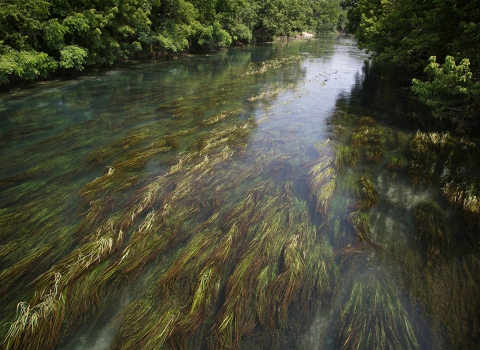Piping plovers are creating nests on Atlantic Coast beaches on the heels of a successful 2019 season, according to numbers announced today by the U.S. Fish and Wildlife Service. The population of small, sandy-colored shorebirds climbed from 1,879 pairs in 2018 to a record high of 2,008 pairs breeding last summer from eastern Canada south to North Carolina.
The milestone marks nearly 35 years of conservation by many partners and the cooperation of beachgoers. The species has benefited from the widespread implementation of management practices including installing symbolic fencing around nests, leashing dogs, posting caution signs, reducing predation, and asking beachgoers to modify their activities near birds and fenced areas.
“While we still have much work to do, the growth we’ve seen in the Atlantic Coast piping plover population, especially in New England, is the clearest possible evidence that we can achieve and maintain recovery,” said U.S. Fish and Wildlife Service piping plover recovery coordinator Anne Hecht. “We are incredibly grateful for decades of ongoing dedicated conservation by all levels of government and other organizations."
The plover’s status has dramatically improved since the species was protected under the Endangered Species Act in 1986. Just 790 breeding pairs survived along the Atlantic Coast. By achieving more than 2,000 breeding pairs, the population is one step closer to meeting one of five science-based goals set in the Service’s recovery plan to recover the population. However, the goal also requires that population gains are evenly distributed across the range, which would reduce risks to the species from storms during the breeding season, oil spills and predation. Numbers remain low in three of the four recovery units, and substantial declines have sometimes followed periods of growth. Population numbers by recovery unit and state since 1986 are also available.
Additionally, recovering the piping plover is more than reaching a certain population size. Other recovery goals relate to maintaining chick production, instituting long-term management agreements with partners, ensuring genetic diversity, and maintaining wintering areas from North Carolina to the Bahamas where the birds spend almost two-thirds of each year.
“Because the plover relies on in-demand beaches, maintaining a healthy population will rely on long-term protection efforts and management by federal agencies, states, private landowners and municipalities,” Hecht said.
The plover continues to be a rare bird; by contrast, there are about 85 pairs of laughing gulls for every pair of plovers on the Atlantic Coast. Partners are grappling with tough issues, including the loss of sandy beach habitat, artificially high numbers of predators, and ongoing disturbances that reduce survival of plovers and their chicks. Years of research confirm that when people or pets disturb plovers and other shorebirds, the birds are stressed, unable to feed, rest or raise families, and in some cases, die.
The latest analysis of the species’ status, completed in March, calls for a number of actions to move the Atlantic Coast population closer to recovery. Recommendations include allowing beaches to respond dynamically to storms that create habitat, allowing naturally created habitat to remain, and developing strategies to reduce threats from rising sea levels.
The Service encourages beachgoers to follow specific steps to help piping plovers and other rare beach wildlife, including sea turtles, terns, American oystercatchers and black skimmers:
- Walk close to the water on the lower beach, so birds can rest and nest on the upper beach. Signs or people usually alert you to these areas, but many normal posting and fencing efforts are delayed this season.
- Keep your distance while birdwatching so the birds feel safe to attend to their eggs and chicks.
- If pets are permitted on beaches, keep them leashed and away from birds. Keep your cats indoors.
- Remove trash and food scraps, which attract animals that might eat piping plover eggs and chicks.
- Do not feed animals on or near the beach.
- Follow all other guidance on signs, and respect all areas fenced or posted for protection of wildlife.


